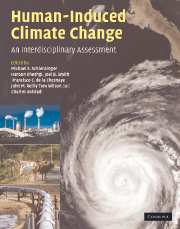Book contents
- Frontmatter
- Contents
- List of contributors
- Preface
- Part I Climate system science
- Part II Impacts and adaptation
- Part III Mitigation of greenhouse gases
- Part IV Policy design and decisionmaking under uncertainty
- 25 Climate policy design under uncertainty
- 26 Climate policy assessment using the Asia–Pacific Integrated Model
- 27 Price, quantity, and technology strategies for climate change policy
- 28 What is the economic value of information about climate thresholds?
- 29 Boiled frogs and path dependency in climate policy decisions
- 30 Article 2 and long-term climate stabilization: methods and models for decisionmaking under uncertainty
- 31 Whither integrated assessment? Reflections from the leading edge
- 32 Moving beyond concentrations: the challenge of limiting temperature change
- 33 International climate policy: approaches to policies and measures, and international coordination and cooperation
- Index
- Plate section
- References
28 - What is the economic value of information about climate thresholds?
from Part IV - Policy design and decisionmaking under uncertainty
Published online by Cambridge University Press: 06 December 2010
- Frontmatter
- Contents
- List of contributors
- Preface
- Part I Climate system science
- Part II Impacts and adaptation
- Part III Mitigation of greenhouse gases
- Part IV Policy design and decisionmaking under uncertainty
- 25 Climate policy design under uncertainty
- 26 Climate policy assessment using the Asia–Pacific Integrated Model
- 27 Price, quantity, and technology strategies for climate change policy
- 28 What is the economic value of information about climate thresholds?
- 29 Boiled frogs and path dependency in climate policy decisions
- 30 Article 2 and long-term climate stabilization: methods and models for decisionmaking under uncertainty
- 31 Whither integrated assessment? Reflections from the leading edge
- 32 Moving beyond concentrations: the challenge of limiting temperature change
- 33 International climate policy: approaches to policies and measures, and international coordination and cooperation
- Index
- Plate section
- References
Summary
Introduction
The field of integrated assessment of climate change is undergoing a paradigm shift towards the analysis of potentially abrupt and irreversible climate changes (Alley et al., 2003; Keller et al., 2007). Early integrated studies broke important new ground in exploring the relationship between the costs and benefits of reducing carbon dioxide (CO2) emissions (e.g., Nordhaus, 1991; Manne and Richels, 1991; or Tol, 1997). These studies project the climate response to anthropogenic CO2 emissions to be relatively smooth and typically conclude that the projected benefits of reducing CO2 emissions would justify only small reductions in CO2 emissions in a cost–benefit framework. The validity of the often- assumed smooth climate response is, however, questionable, given how the climate system has responded to forcing in the geological past. Before the Anthropocene, the geological time period where humans have started to influence the global biogeochemical cycles considerably (Crutzen, 2002), the predominant responses of the climate system were forced by small changes in solar insolation occurring on timescales of thousands of years (Berger and Loutre, 1991). Yet this slow and smooth forcing apparently triggered abrupt climate changes – a threshold response where the climate system moved between different basins of attraction (Berger, 1990; Clement et al., 2001). Anthropogenic forcing may trigger climate threshold responses in the future (Alley et al., 2003; Keller et al., 2007).
- Type
- Chapter
- Information
- Human-Induced Climate ChangeAn Interdisciplinary Assessment, pp. 343 - 354Publisher: Cambridge University PressPrint publication year: 2007
References
- 5
- Cited by



